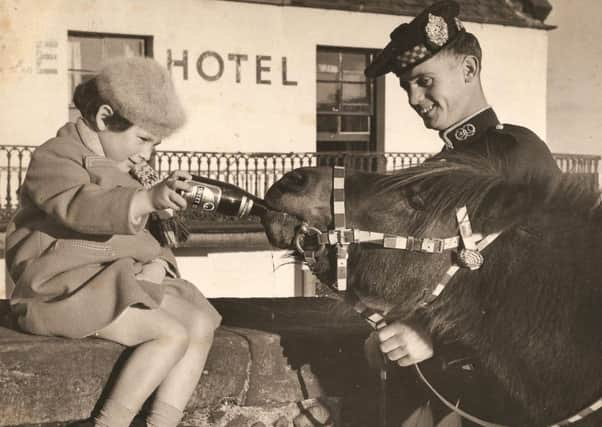In pictures: Cruachan, the beer drinking army pony


Cruachan became the mascot for the Argyll and Sutherland Highlanders in 1929 after the pony was gifted to the regiment by Princess Louise, the daughter of Queen Victoria, who was the regiment’s first Colonel-in-Chief.
Known originally as Tom Thumb, it was felt a more imposing name was required for the regimental mascot and Cruachan, the battle cry of Clan Campbell which is traditionally associated with the regiment, was chosen.
Advertisement
Hide AdRod Mackenzie, assistant curator of the Argyll and Sutherland Highlanders Museum at Stirling Castle, has shared with The Scotsman a rare collection of images of the mascot and other animals kept by the soldiers.
He said: “It was common place for soldiers to have pets especially when stationed within barracks. Not only did they provide companionship for individuals but they were also used to keep vermin at bay such as rats, mice and snakes.
“There has been a myriad of pets kept by the Regiment over its history in the form of dogs, cats, birds and even more exotic animals such as bears leopards and panthers
“However, the Mascot had a very specific role to represent the Regiment during ceremonial occasions and to act as an animal ambassador.
“Over the centuries, goats, rams and even a red deer have become mascots of the Argyll and Sutherland Highlanders in its various forms, however there is one animal which has become synonymous with the regiment and that is Cruachan.”
Cruachan I occasionally escaped from his stable and kick out at an unwary passer-by. Also known to rear up for a sugar lump, he continued to serve as the mascot until his retirement in the late 1930s.
Advertisement
Hide AdA second Cruachan was presented to the Battalion in 1952 with the pony march at the head of the Unit’s return from the Korean War and the Far East.
Tens of thousands lined Princes Street in Edinburgh to watch the parade - with the little pony right at the front of the procession.
Advertisement
Hide AdSlightly taller than his predecessor, Cruachan II was known to enjoy several beers and famously bit through Queen Elizabeth’s glove during a parade.
He saw service in several places such as Germany and Cyprus before retiring in 1979.
Cruachan III was purchased in 1995 by the serving soldiers and led the Battalion during the series of Homecoming Parades when the soldiers returned from the 2008 tour of Afghanistan.
These parades were among the last duties that Cruachan performed as the mascot for the Argylls.
After the new Royal Regiment of Scotland was formed in 2006, Cruachan gradually became the mascot for the entire unit.
His original green and gold saddle cloth with his Argyll and Sutherland Highlanders regimental badge was replaced.
Advertisement
Hide AdA full set of campaign medals which reflected both his length of service and the service of the soldiers during his time as regimental mascot were pinned in place.
Cruachan III, who loved a carrot, retired in 2012 age 23.
Cruachan IV was presented to the Royal Regiment of Scotland in 2012 and undertook his first official engagement in 2013.
Advertisement
Hide AdLooked after by a Pony Major, it takes about three hours to brush Cruachan’s coat, comb his mane and tail, polish his hooves and finally dress him in his regimental saddle cloth.
It was Cruachan IV who went to nibble on Prince Harry’s fingers this week when he visited Edinburgh Castle with his fiancée Meghan Markle.
Mr Mackenzie said: “The various Cruachans have been a little temperamental and stubborn at times but most have enjoyed being the centre of attention drawing crowds wherever they serve.”